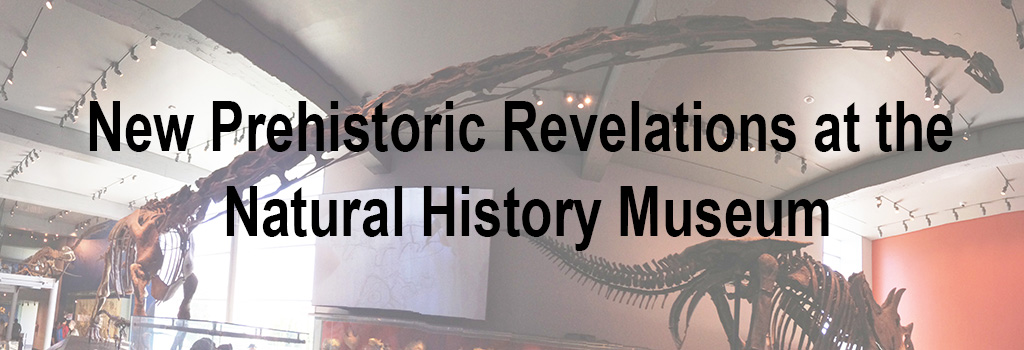

|
By Alex Wowra
Maureen Walsh, Assistant Collections Manager for the Dinosaur Institute at the Natural History Museum (NHM) in Los Angeles County, jumps from one thought to the next. Leading me through several segments of the NHM that are either dedicated to different aspects about the work on dinosaurs or related areas such as avian research, we are constantly moving and so is her mind. She perfectly embodies the museum’s efforts to inform and teach.
Driven by passion, determination and expertise, she is also proud to be a part of these efforts. “This dinosaur hall is the best in the world,” she claims, “it is very up to date, and I like the story we tell. It tells the story of diversity of dinosaurs and of what is not a dinosaur as well.”
|
Encountering the Former Rulers of this Planet - Photo Gallery |
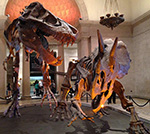
|
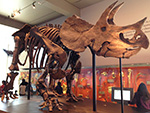
|
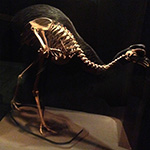
|
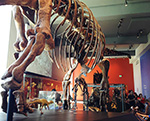
|

|
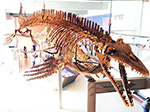
|
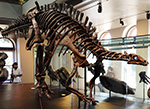
|

|
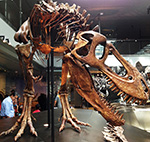
|
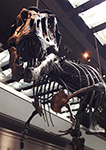
|
Walsh, who actually focuses on the preparation of early cretaceous birds, has just returned from a trip to China, where she worked on research projects in avian evolution with multiple institutions in Beijing, Dalian and Henan.
When asked, how this relates to the museum’s work on dinosaurs, she explains, “birds are dinosaurs,” hinting that we can learn about the evolution of dinosaurs by finding out more about avian evolution.
Aside from projects in China, the NHM has been working on findings from four different major sites, she notes. They include the Kirtland Formation, in New Mexico , which hosts remains dating back to the late Cretaceous, where scientists have started their operations in 2012.
In addition, the museum’s newest projects in collaboration with Dr. Martin Sander of Bonn University, are located at the Tobin and Favret Formations in Nevada, from which Ichthyosaur evolution stems.
The museum undertakes several efforts to educate children and adults about dinosaurs, Walsh states.
For one, the museum mentors students at Petrified Forest National Park in Arizona, which bears fossils from the Triassic era.
Walsh then leads me through the Dino Lab, where scientists work on projects such as the preparation of fossils while they are on display for museum visitors. Signs that describe the name of the project or animal which they are currently working on provide further information.
When looking for a a mix of entertainment and education instead, visitors can also attend several live-performances of paleontologists and puppeteers, called Dinosaur Encounters, which “bring the dinosaurs back to life,” as the NHM’s website states. These shows aim to illustrate how these prehistoric animals lived, so visitors can better understand dinosaur anatomy, possible behavior and movement.
Meanwhile, to ensure that the knowledge about dinosaurs is passed on to the next generation, Dr. Luis Chiappe, VP of Research and Collections and Director of the Dinosaur Institute, serves as an Adjunct professor at the University of Southern California and advises Masters and PhD students. While Walsh is excited to talk about Dr. Chiappe’s accomplishments, she is even more eager to tell me about the project the Dino Lab is currently working on.
“Since 2007, scientists from the museum have been excavating fossils from the Utah Morison Formation, which date back to the late Jurassic period,” she tells me. This is also where the NHM found one of the highlights of their recent efforts of unearthing dino bones: a sauropod called Gnatalie.
Found in 2007, Gnatalie may represent a new species of longneck, which could have measured approximately 80 feet in length and lived roughly 150 million years ago.
As As a previously conducted interview with Dr. Luis Chiappe reveals, Gnatalie received her nickname because during one season of digging out her bones, the gnats were so plentiful and intense that the paleontologists decided the name seemed appropriate for the creature.
Aside from Gnatalie, at the site, which is part of an ancient flood plain, the team of scientists made additional discoveries of at least two other sauropods, an Ankylosaur, some theropod remains and even more.
When dinosaurs like Gnatalie are discovered, they are then mapped and excavated to the point where they can be roughly identified and ultimately will be dug out entirely in a sort of rock-bed that Walsh and her colleagues refer to as “jacket.”
“The jacket is put around the fossil with the rock that is close to the fossil because you wanna protect it and keep it stable… you cant do the prep work out there but you have to wrap it up and cover the whole bone in plaster saturated burlap and then bring it back,” Walsh notes.
The jackets are labeled in alphabetical order and usually one season’s expedition will approximately go through an entire alphabet, according to Walsh.
“With Gnatalie we already have a J-jacket you go to Z… you start AA, BB etc. it’s a horrendous job,” Walsh explains.
The process can take years from the point where you expose a bone, follow it, remove the surrounding rock (matrix), dig it out, transport it and finally finish the process of extracting the fossil from the jacket and fully prepping it, Walsh says.
Thus, keeping records is crucial to the process in order to keep track of where every single element belongs within a specific jacket.
As Walsh walks me through the Dino Hall exhibition, she mentions Thomas, the T.-rex - another significant discovery made in 2001/02. She shows me the Tyrannosaurus rex Growth Series, which she helped to put up when she participated in the creation of the new Dino Hall, which opened last year in honor of the museum’s 100-year birthday celebration.
“I’m guessing about 70 percent of this skeleton are real bones,” she says while she points at one of the T.-rex on display. Skulls however, she explains to me, are almost always casts.
This is also true for the tyrannosaurus exhibition, which includes a baby, a juvenile and a sub-adult specimen, but the preserved remains of their real skulls are also put in display in a separate glass case.
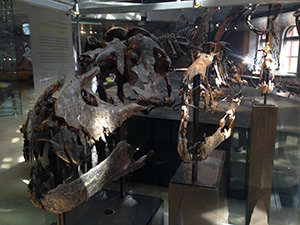
The difference between cast and real fossil becomes evident when one looks closely and once you develop an eye for it, she says.
When carefully examining the skeletons, I can see the difference in the rugged, rough-looking bones and the smoother design of the casts.
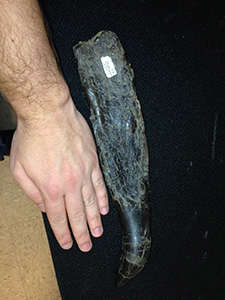
Walsh then takes me to the last stop of our tour and shows me the ancient marine reptiles on display.
The highlight here is the unparalleled exhibition of a plesiosaur with its unborn child. “This was the first example of live birth in a plesiosaur,” Walsh explains and points out the adult fossil from the fetus. They have no evidence of predation on them, no teeth marks, and are in the abdominal cavity, which suggests that it was a fetus.
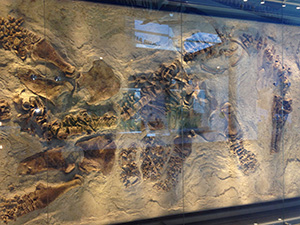
This teaches us that ancient marine reptiles, such as plesiosaurs, gave live birth and did not lay eggs, she explains.
Even though this was new to me, Walsh has one last revelation to offer me.
“Marine reptiles were not dinosaurs, in order to be a dinosaur you have to be terrestrial and these animals clearly just adapted so well to their environment in the water that they started giving birth there.”
While all this new way of recognizing diversity is already making my head spin, Walsh asserts that her favorite are still the birds.
As if all these projects and specimen providing a workload for scientists for the next several decades weren’t enough, Walsh’s eyes glow when she leaves me with the one last sentence that perfectly illustrates her seemingly endless motivation.
“Every bird tells you something new,” she rejoices.